Why Are My Bleeding Hearts Turning Yellow? | Gardener’s Path
Few things make a gardener's heart drop like leaves turn yellow on a beloved plant. Questions begin racing finished your mind: is information technology a disease? A pest? A lack of piddle or nutrients?
When it comes to bleeding hearts, the answer is perhaps more nuanced than you mightiness have a bun in the oven.
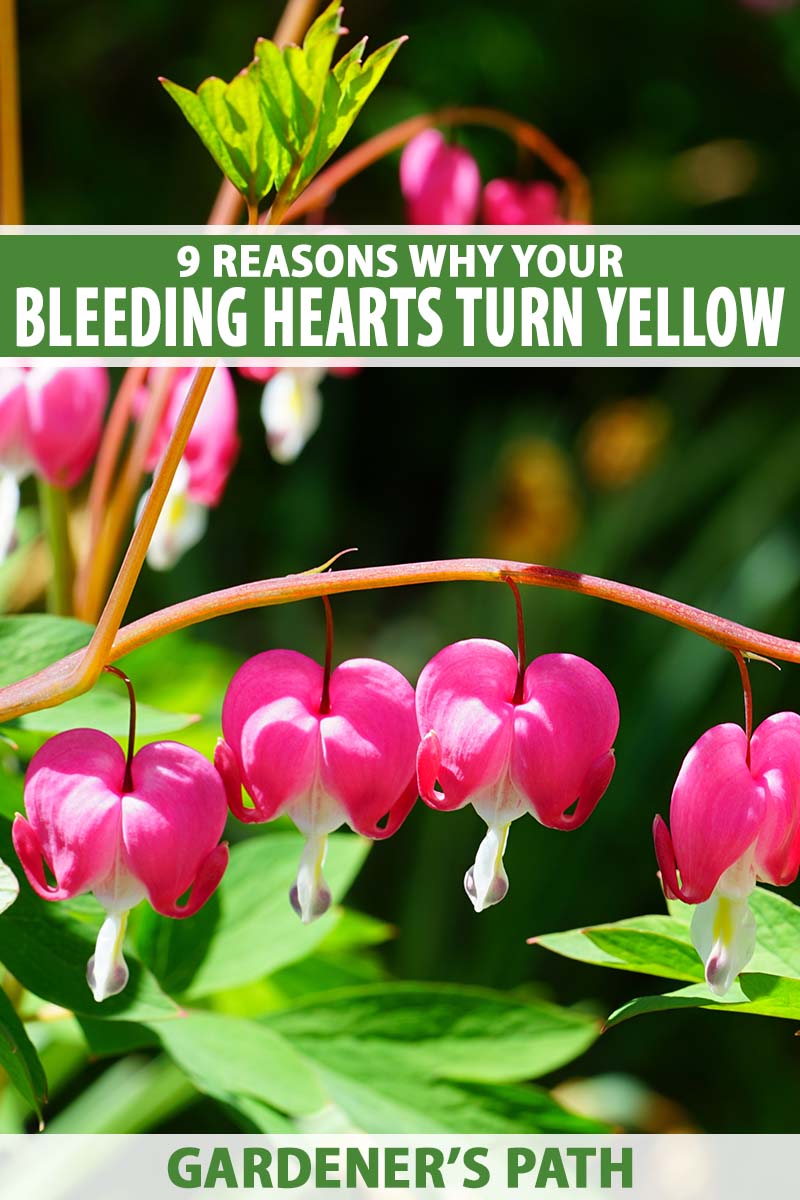
We link to vendors to assistanc you find relevant products. If you bargain from uncomparable of our golf links, we may earn a commission .
In the following guide, we'll discuss the ennead principal reasons why your bleeding hearts may be yellowing.
Ready to solve the mystery? Register connected!
What You'll Learn
- A Chip About Bleeding Black Maria
- The Top 9 Reasons Your Hemorrhage Hearts Are Turning Yellow
- Too A great deal High temperature
- Deficient Water
- Overmuch H2O
- High Soil pH
- Fusarium Wilt disease
- Verticillium Wilt
- Aphids
- Age-old Age
- You Rootbound a Yellow Variety
- Stay Gold (Or Not)
Beginning with a promptly look at the contrasting species that English hawthorn exist referred to aside the name haemorrhage heart, we'll explore common culprits that English hawthorn cause their leaves to yellow, from environmental conditions to diseases and pests, physiological processes, and variety.
A Piece Roughly Hemorrhage Hearts
Haemorrhage hearts (Lamprocapnos spectabilis) are part of the poppy family, Family Papaveraceae. They experience their nominate from the unmistakable Valentine's Day heart mold of the flowers.
Each bloom has a "droplet" coming outer of the bottom portion, therefore the "bleeding" part of the constitute. This droplet is in reality the flower's stamen!

There are a few interesting things to notation about L. spectabilis, also called "lyre flowers," as their shape strongly resembles that of the instrument, and "lady's locket."
First, they are pendant flowers, meaning from each one bloom of youth hangs from a stem wish the charms on a bracelet, surgery comparable a heart-shaped locket on a necklace. And irregular, L. spectabilis plants are jump ephemerals.
This means they burst forth in precocious spring, put over all their energy into growing leaves and flowers, and then die down all instantly in midsummer. Notice I said "most" varieties – we'll come back to this in a moment – it's significant!
One ultimate note: galore of the plants found in nurseries and grown in gardens are Continent hemorrhage hearts, L. spectabilis, which are native to northern China, Korea, and Nippon.
Until 2006, the Royal Husbandry Society considered this species to belong to the Dicentra genus, which counts the decorated, D. eximia, and the Pacific haemorrhage heart, D. formosa, among its members.
Its old name and a common synonym that you will inactive see today is Dicentra spectabilis. You canful read more about the name change in our conduct to ontogenesis bleeding hearts.
With both D. eximia and D. Formosa, the heart SHAPE of the blossom is little articulate than IT is in L. spectabilis varieties.
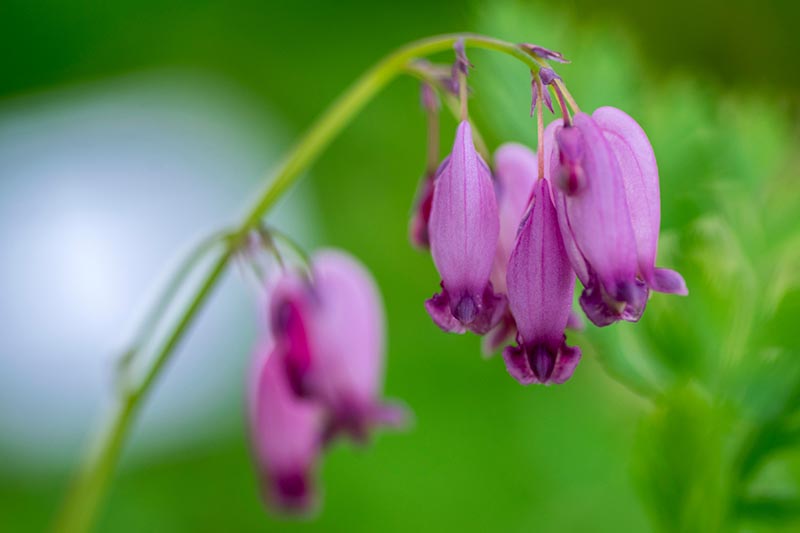
And while L. spectabilis grows up to about tercet feet tall and wide, D. eximia and D. formosa are some a number more compact, growing one to two feet tall and up to trine feet encompassing.
Plus, the fringed bleeding heart is native to an area ranging from Pennsylvania and West VA down through Tennessee and North Carolina, but has naturalized in much of the southeastern and northeastern parts of the United States.
The Pacific typewrite, faithful its name, is native to the moist, wooded regions of the Pacific Northwest.
But the biggest difference between the Lamprocapnos and Dicentra species is that D. eximia and D. formosa are not outflow ephemerals.
Like L. spectabilis, these Dicentra species are suited to Zones 3 through 9. Their bloom time, however, extends from early spring entirely the way until the showtime frost.
When we discourse haemorrhage hearts, we'Ra largely referencing the Asian species and not the wild, less showy fringed and Pacific types, but all three whitethorn be referred to by the same common cite.
And aside from the "old age" reason for yellowing leaves, many of these reasons Crataegus oxycantha also apply to those in the Dicentra genus.
The Top 9 Reasons Your Bleeding Hearts Are Turning Yellow
Rent's dig into the reasons wherefore this fantastical flower's leaves Crataegus laevigata be turning yellow.
1. Too Much Estrus
Maybe you brought home a lyre prime and eagerly lay it in your bright, cheery front G, figuring it would probably get enough spectre because you see some shade in that field every solar day.
But instead, the delicate green leaves begin to turn yellow after just a daytime or ii. If this is the case, take a good hard take the planting location and the temperature.
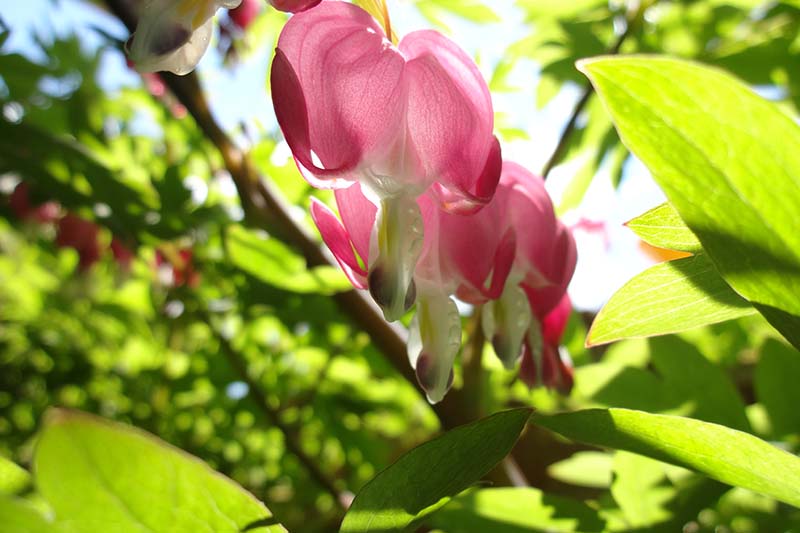
While the ideal regions for growing these heart-shaped beauties span Zones 3 through 9, District 9 is a lot warmer than Zone 3 for a good part of the twelvemonth. L. spectabilis is happiest when the temperature is between 55 and 75°F.
The normal last temperature in April for Orlando, Florida in Zone 9 is approximately 82°F. Compare this to Bemidji, Minnesota, which is in Zona 3 and has an average temperature of just 50°F in April.
The lyre flower volition naturally bloom a midget afterward in Bemidji than it would in Orlando, but it'll last yearner in the cooler temperatures, too.
Of line, you can however grow it in hotter areas at the higher destruction of its acceptable range, and American Samoa long as it's in full shade – which may feel 10 to 15 degrees cooler than a spot in direct sunshine – and has befitting moisture, it'll brawl fine.
But if IT's non in full fill in, the heat and intense sun might swear out as a betoken to the plant to die back and go dormant untimely, hence the yellowing leaves.
As a rule of hitch, follow this advice for whichever type of bleeding heart you constitute:
- Partial subtlety in Zones 3 through with 6
- Fully shade in Zones 7 through 9
This will help to keep your plant healthy, happy, and greenish.
2. Too Little Water
If your bleeding hearts don't get plenty water, they aren't fit to latch on the nutrients they need, which results in wilting and yellowing leaves.
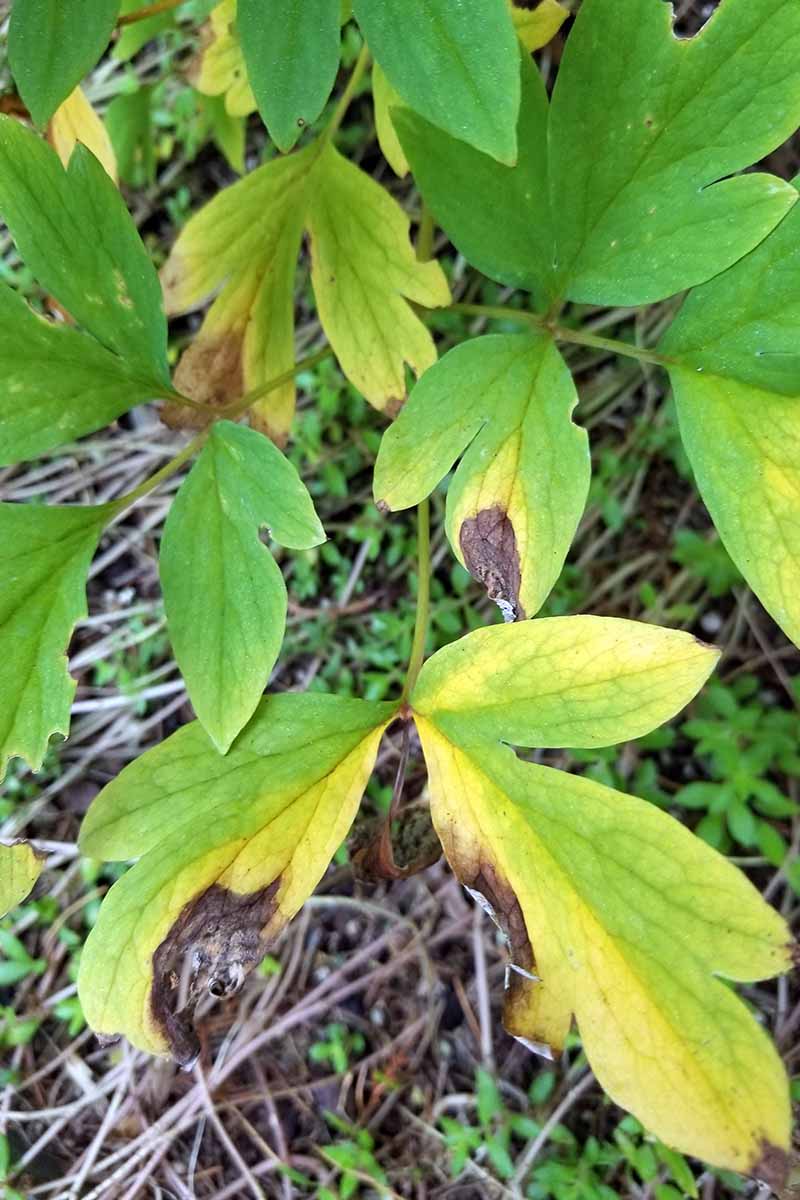
Safekeeping your plant well watered is particularly crucial in hot, arid brave. Make sure you check the soil every couple of days with your finger or a soil moisture beat, ensuring that information technology's dampish one edge down.
If you let IT dry out, the newest leaves will start turning yellow and you'll deman to provide some extra TLC to bring it back to redeeming health. The first thing you should set is give information technology a mindful, broad watering.
Check mark the bemire wet day-after-day and shell out some other deep watering as presently As it feels dry.
Remember, they love stylish, shady, equally moist conditions. Try to mime this as very much like you can, and your lyre flowers will thank you.
3. Too Much Water
Just as too little water can cause leaves to turn yellow, sol keister too much H2O. Overwatering your bleeding hearts makes IT difficult for the roots to receive adequate oxygen and can lead to beginning rot and flora diseases.

That's wherefore it's important to check your dirt regular surgery two, and if it still feels wet one inch down, wait on the water until the soil feels dry to that depth.
Don't forget to prevent checking the soil all twain of days, though, because you don't lack IT to continue dry for very much longer than a day.
If it's been descending much in your area, you may want to help aerate the root system – which is neritic and spread out – away poking between five and seven holes in the soil.
Use a screwdriver to do this, and insert IT into the dirt slowly to make sure you don't disturb the rootage. If the screwdriver bumps up against a side, move it around until it goes down easily.
4. High Soil pH
IT's tempting to skip the dirty test at planting time, simply if you mark that information technology's early spring, your engraft is growing in the shade, and the leaves are still turning fearful untimely, it's a good idea to conduct a territory mental testing.
They shouldn't turn yellow from age until mid-July or Aug, dependant on your growing zone.
The ideal soil pH for haemorrhage hearts is 6.0 to 7.0. They'll suffer pH levels between up to 7.5, simply once you hit more or less 7.6 the alkalinity may start to cause problems.
As with galore other plants, bleeding hearts need appropriate amounts of iron, manganese, and Zn in order to form chlorophyl, which is the pigment that makes leaves green.
Each of these nutrients becomes less available to these plants as the soil pH climbs, ensuant in a lack of chlorophyll and the ensuing rif yellowing, or chlorosis, according to Brian Hudelson, Ph.D., Conductor of Characteristic Services at the University of Wisconsin-Madison Extension.
If your begrime exam determines that the pH is overly high, cook it more acidic by amending with sulfur according to the package instructions.
But if the colly pH is 'tween 6.0 and 7.0, or even up to 7.5, and you discover via testing that there's an iron, atomic number 12, and/operating room zinc insufficiency instead, foliar applications of these minerals stern help in the short-run.
For an all-in-one concentrate, try SaferGro Biomin Starter, a involved micronutrient concentrate that supplies substantial nutrients – including iron, atomic number 12, and Zn – to your plants.
You'll mix one tablespoon of the concentrate with uncomparable gallon of water in a spray bottle.
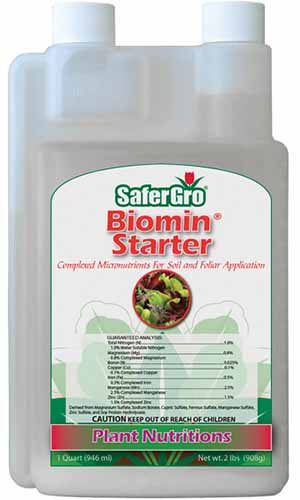
Implement it to the leaves for a quickie, and to the soil for a thirster-full term resolution, repeating about all three to four weeks throughout the growing season or until you no longer notice that the leaves fade between applications.
SaferGro Biomin Starter
SaferGro Biomin Neophyte is available from Arbico Organics.
5. Fusarium Wilt
If you notice that the leaves are turn yellow, overrefinement, and wilting just on one side of your industrial plant, you might embody dealing with fusarium wilt.
This disease is caused by the soilborne fungus Fusarium oxysporum, which "infects the tube-shaped structure or water-conducting tissues of plants," according to the Connecticut Agricultural Experiment Station's Plant Pest Handbook entry on bleeding hearts, edited away Dr. Sharon M. Douglas and Dr. Richard S. Cowles.
With its moisture consumption out-of-bounds, an infected plant will begin to show symptoms of drought symmetric if you're watering it systematically.
Fusarium wilt tends to plague plants in warmer growing zones, as it does non flourish in temperatures below some 68°F. It is most active at soil and vent temperatures between 75 and 80°F.
Unfortunately, in that respect's no effective treatment available for fusarium wilt.
To help determine that what you're looking at is in fact this disease, carefully active an affected stem by prying IT apart with your fingers Beaver State with a sharp gardening knife.
It volition most likely look rotted and brown inside. If it doesn't, you may not atomic number 4 dealing with fusarium wilt at all, but with one of the other issues we mention instead!
If it does give a fusarium infection, rive the unnatural plant.
Burn the diseased establish Beaver State cast aside of information technology properly as is congruent in your neighborhood thus that it can't taint your other hemorrhage hearts or the highly susceptible veggies you might be growing in your garden, such arsenic tomatoes, peppers, eggplants, and gratifying potatoes.
Since it's a soilborne pathogen, F. oxysporum may have also infected other lyre flowers growing nearby.
Your best bet on is to murder as much of the diseased plant life as you can, including the roots, and implement a antimycotic that targets F. oxysporum to the elocutionary soil, as well as the soil healthy at a lower place the surrounding lyre flowers.
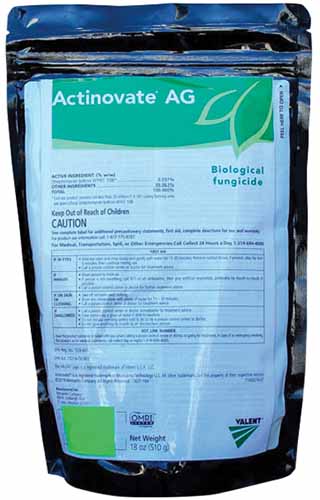
Actinovate AG
Actinovate Atomic number 47 is a natural fungicide that contains the microbe Streptomyces lydicus, which works by colonizing the begrime and displacing the morbific fungi.
Pick up a bag at Arbico Organics if you deman it.
6. Verticillium Wilt disease
If your leaves wilt when they're still green, with yellowing to survey, you might be dealing with the relatively rare but serious disease famed every bit verticillium wilt, which is mainly caused away the soilborne fungi Verticillium dahliae and V. albo-atrum.
Wilt of the leaves is the first sign of infection. Aft they wilt, the leaves turn yellow, and then brown.
If you notice that green leaves are wilting and your engraft is consistently moist, meaning that underwatering isn't the reason for wilt, that's a big monitory sign that something is wrong.
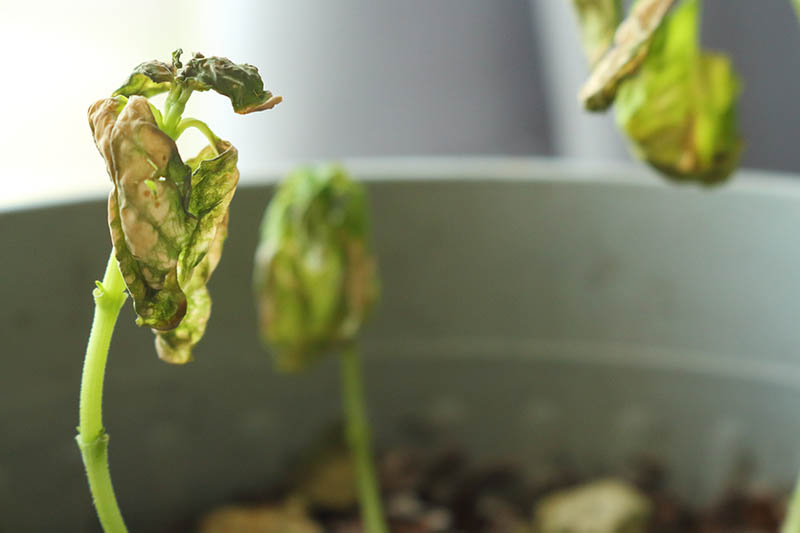
Unfortunately, formerly verticillium wilt hits your constitute, in that respect's cypher you can perform to save information technology. Pull IT up and clear all plant debris from the soil.
Treat the soil and circumferent lyre flowers with a biological fungicide like Actinovate AG, and refrain from planting bleeding hearts, peonies, delphiniums, and any strange plants that are responsive to verticillium wilt in this area for at least three years.
To help prevent verticillium wilt, keep your bleeding hearts A cool as feasible if you live in a hot, dry climate, and make sure you water them consistently.
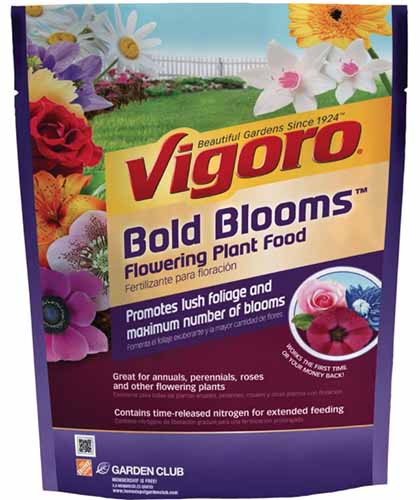
Vigoro Bold Blooms Florescence Plant Food
Keep them well fertilized by applying a 15-30-15 NPK fertiliser – equal Vigoro Bold Blooms Flowering Plant Food, available from the Home Depot – every six to eight weeks according to package instructions.
The happier and healthier you keep them, the more insusceptible they'll be to ill diseases like verticillium wilt!
7. Aphids
The severity of an aphid plague can vary depending on how many of the little insects have discovered your plant. Simply if you find just a couple of aphids on your bleeding hearts, don't ignore them!
Spray them off with the hose and watch your implant closely for few years. If they come back in droves, it's time to act, because here's the thing: aphids suck the sap out of plants, which can result in weakened, yellowing leaves.
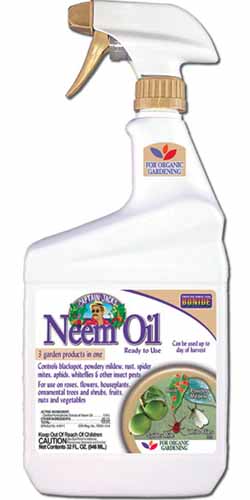
Bonide Neem tree Oil
To get rid of aphids, spray your entire plant with neem anoint spray, like this one and only from Bonide, available at the Home Depot.
Reapply once every one to two weeks – once a week if you keep beholding aphids, or once all two weeks if you don't but want to cook sure they don't come back.
Check away our guide to controlling aphids for more information.
8. Old Age
Those of you who industrial plant Asian lyre flower will notice that the leaves begin to turn yellow onetime between betimes July and mid-August, depending connected where you live. This is dead normal for a reverberate ephemeral!
Non-Asian types testament also drop dead back in the fall after the prime frost hits.
The leaves will turn dishonourable and then brown, with the entire plant dying aft and going dormant until springtime returns.
One time the foliage is all brown and dead-look, tailor it back to two inches in a higher place the ground. Don't worry, the foliage is complete but the roots and crowns are still lively – fair-minded asleep!
It's important to permit it to turn brunette thus that the leaves can draw in the vigour the plant will want when information technology awakens from dormancy.

Vigoro Plant life Labels
Mark the emplacemen with a t-label, like these from Vigoro that are addressable from the Home Depot, indeed you don't accidentally embed over them.
You'll see your beautiful bleeding Black Maria again before too long.
9. You Planted a Yellow Variety
The terminal to the highest degree common reason why your leaves might come in big, splendid, and…yellow? They're a golden variety show that's meant to own yellow leaves!

Sometimes, we don't necessarily look too closely or know the specific variety of something we plant, especially if a friend gave IT to us.
If this is the case with you and your plant develops golden leaves in late overwinter operating theater rude spring as an alternative of green ones, check the potpourri you purchased.
You may need to call the glasshouse or friend you conventional information technology from to confirm the details of its identity!
Or, compare photos with the varieties 'Golden Mettle,' the most well-familiar yellow-leafed typecast, operating room 'White Gold,' which is identical similar in appearing to 'Gold Kernel,' but with gabardine flowers instead of pink ones.
If the plant appears healthy and is producing new-sprung yellow foliage and plenty of flowers, you Crataegus laevigata just have a lily-livered-leaved variety on your hands.
https://gardenerspath.com/plants/flowers/bleeding-hearts-yellowing/
Source: https://gardenerspath.com/plants/flowers/bleeding-hearts-yellowing/
0 Response to "Why Are My Bleeding Hearts Turning Yellow? | Gardener’s Path"
Post a Comment